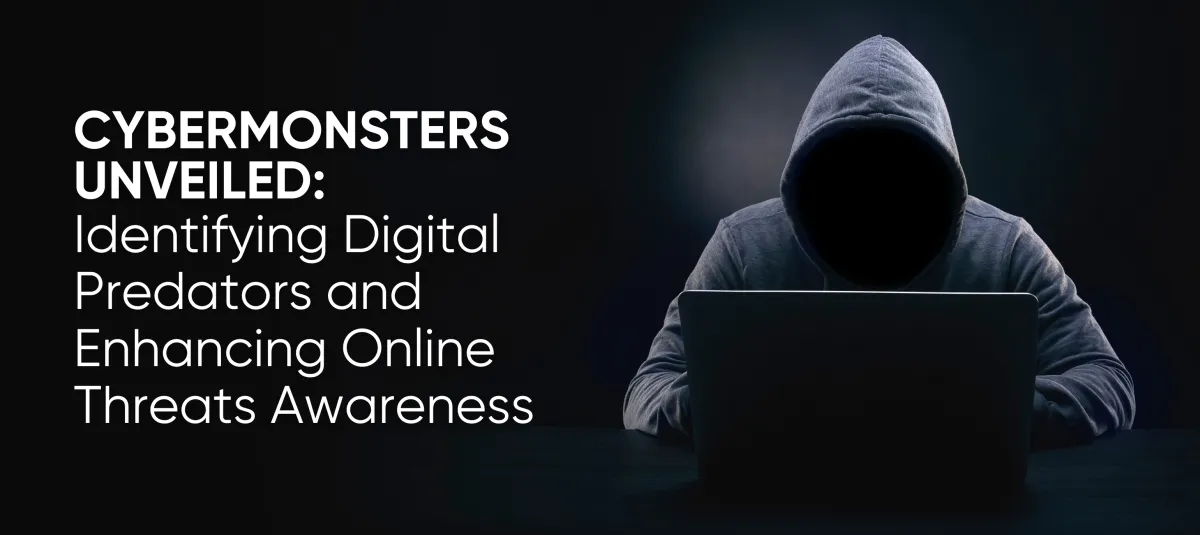You are what you click!
Learn how to make cybersecurity your way of life in an easy and guided way.
You are what you click!
Become Cyber savvy
EXPLORE BLOG BELOW
You are what you click!
Become Cyber savvy
You are what you click!
Become Cyber savvy
You are what you click!
Become Cyber savvy

Cybermonsters Unveiled: Identifying Digital Predators and Enhancing Online Threats Awareness
In the vast expanse of the internet, there’s much to be curious about. From adorable cat videos to invaluable life hacks, the online world offers an array of wonders. However, as you navigate this vast digital universe, it’s essential to be aware of lurking Cybermonsters. But what exactly are these “Cybermonsters”, and why should you be concerned about them?
In this post, we’ll pull back the curtain on common Cybermonsters, their sneaky tricks, and most importantly, how to guard against them. Consider this your guide to unveiling internet villains and enhancing awareness around online safety. Let’s dive in!

Introducing Cybermonsters: Not Just Digital Myths
At first, “Cybermonsters” might sound like something from a kids’ storybook. But make no mistake; they are very real. They represent the hidden threats sneaking in the vast corners of the internet, waiting for an opportunity to exploit unsuspecting individuals. Think identity thieves, malware spreaders, and deceptive scammers. The truth is, no one is entirely immune. Every click, every download, or every shared detail could potentially be an open door for these digital predators.
Furthermore, Cybermonsters come in many forms, but often share key traits:
Deceptive: They expertly disguise malicious links, attachments or intent behind highly convincing messages, websites and profiles that appear trustworthy. Sophisticated social engineering and technical tricks are used to lower victims’ guard.
Opportunistic: Cybermonsters actively seek out unaware, vulnerable targets and ruthlessly strike when they detect security defenses are down, like outdated software or reused passwords. They capitalize on any window of opportunity.
Adaptive: They continually evolve tactics to bypass protections and exploit new trends. Cybermonsters are chameleonic in their ability to alter approaches, leverage new technologies like AI for attacks, and innovate ways around security measures.
Persistent: Cybermonsters relentlessly barrage targets through multiple channels over extended periods of time. Their tenacity and patience often wear down those who ignore early warnings. Like predators, they do not give up easily on a potential target.
Greedy: Monetary gain through theft, extortion or fraud primarily motivates most attacks, rather than ideology. However, there are “Hacktivist” Cybermonsters that will target victims based on social, political or economic causes aligned with their ideology. Their greed manifests through destruction or reputational damage.
Cowardly: Cybermonsters hide behind screens and complex technical tricks, counting on instilling fear in victims. Anonymity and obfuscation allows them to avoid directly facing the harm they inflict.
By understanding these common behaviors, we can move past panic and toward proactive responses. Remember, Cybermonsters lose power when dragged into the light!

Cracking Down on Common Misconceptions
The world of cyber safety might seem like a jumbled maze of jargon and techy-talk. This often leads to feelings of overwhelm or helplessness, especially when threats seem ever-evolving. Tackling this requires dispelling some myths:
Myth: Attacks only target high profile victims
Reality: A common notion is, “I’m just an ordinary person, not famous or rich – why would cyberthreats target me?” But these predators don’t discriminate. Whether you’re shopping online, uploading family photos, or using education apps, you could be targeted. However, arming yourself with knowledge allows you to browse safely, without constantly looking over your virtual shoulder.
Myth: Cybersecurity is just for the tech-savvy
Reality: While deeper expertise does help, even those with minimal tech skills can make significant strides in protecting themselves, their families or businesses online. Learning a few core concepts around threats and basic precautions gives you invaluable security tools. Cyber safety fundamentals are accessible to all.
Myth: It’s time-consuming
Reality: Simple everyday habits like using strong unique passwords, not clicking suspicious links, and enabling two-factor authentication can be tweaked to bolster your cyber safety without taking up significant amounts of time. Small changes make a big difference. Listen, one action a day can keep the Cybermonsters away!
Myth: It requires constant, strenuous effort
Reality: Once initial precautions like antivirus software, password managers and routine updates are set up, many protective measures run quietly in the background, requiring little daily effort. Vigilance around threats does take attention, but not constant exhausting work. Cyber safety can become second nature. You got this!
Myth: Secure sites and apps mean my info is safe
Reality: Even well-known, seemingly secure sites suffer breaches. While protections help, no one is bulletproof. Limit shared data to essentials and monitor accounts closely for suspicious activity. Stay vigilant rather than relying on others to fully safeguard your information. Remember, you are in charge of your cyber safety!
Myth: It’s too complex for me to understand
Reality: While advanced hacking techniques require technical expertise, basic security precautions are simple and highly effective once learned. By grasping password safety, phishing cues, and safe browsing habits, you gain invaluable skills. Knowledge truly is power when it comes to fundamental cybersecurity.
Myth: There’s nothing I can really do to stop it
Reality: Individual awareness and preparedness meaningfully improve safety and reduce cyber risks, even if not eliminating them entirely. Don’t underestimate the huge impact that simple cyber safety habits and practicing cyber mindfulness can make. It’s empowering to know we can disrupt threats.
Myth: Major attacks are rare
Reality: Large-scale cyber crime happens on a daily basis globally, for example every 11 seconds a ransomware occurs. But consistent education and caution by individuals thwart the majority of attacks and mitigate overall damage. So while major incidents make headlines, they are just the tip of the iceberg. Staying vigilant and mindful prevents most strikes before they escalate.
Staying rational rather than fearful allows us to take meaningful actions in the face of cyber threats.

Spotting Cybermonsters and Their Tactics
Understanding is the first line of defense. What might an online threat look like? From suspicious emails to too-good-to-be-true offers, learning to identify potential dangers can save a lot of heartache. Additionally, understanding some recent cybermonster attacks can offer insights into their evolving tactics.
Malware
One particularly deceitful digital predator is “malware” – malicious software installed without your consent. Malware enables spying, theft, and even device hijacking or ransom.
Trojan horses
disguise malware within benign-looking apps or files. Once downloaded, they compromise the system.
Phishing
Phishing uses email to trap victims into clicking on bad links or opening infected file attachments. The emails pretend to come from trusted sources like banks, companies, or contacts you know. They use lies and tricks to get you to click.
If someone clicks the phishing link or opens the attachment, it secretly installs software “malware” onto their computer or device.
Phishing emails try to trick you by:
Creating a false sense of urgency or excitement so you click without thinking first
Using fear tactics about things like canceled accounts to get you to react
Looking like they come from real contacts by copying logos and styles
Getting you to enter your login information on fake sites accessed through their links and more.
Ransomware
The aptly named “ransomware” takes data hostage by encrypting files until payment is received. Ransomware is often distributed through malware or by exploiting vulnerabilities, and can rapidly spread to paralyze entire systems once inside.
With businesses and individuals held digitally captive, ransomware criminals pressure victims into paying substantial sums to regain access to their data. Unfortunately, some who give in to extortion demands never successfully recover their information, adding insult to injury. The FBI recommends against paying ransoms, as doing so incentivizes and funds criminal enterprises to continue attacks at larger scales.
Scams
Scammers run cons and fraudulent schemes to pilfer money or sensitive details from unwitting marks. They often pose as trusted entities through:
Phishing – Emails/calls with malicious links requesting login, bank or personal info.
Vishing – Deceptive voice calls manipulating users into sharing financial details or making payments.
Smishing – Text scams with links to fake sites capturing credentials or loading malware.
Social Engineering – Manipulative psychological tactics playing on emotions like fear.
Hackers
Hackers breach defenses to infiltrate systems and networks through technical exploitation. Motives range from criminal profit to anarchic mayhem. Brute force attacks, phishing and social engineering provide initial access. Then vulnerabilities are leveraged to elevate privileges, spread malware, and extract data. Protections are thereby broken from the inside out.
By understanding the variety of Cybermonsters and their shadowy tactics, we shed light on precisely how to guard against them. Just remember monsters under the bed lose their power once you turn on the light!

Simple Steps for a Safer Online Experience
At its core, enhancing online security requires shining a light on the Cybermonsters’ shadowy tactics and choosing knowledge over fear. By learning to identify common threats, honing your instinct, dispelling myths and taking preventative actions, you significantly disrupt the hunt. Additionally, empower yourself through these three basic recommendations:
Knowledge is Power: Dive deep into cyber safety self-defense training and resources and equip yourself with the knowledge to tackle threats and protect yourself, family or business. The Happily Ever Cyber bundle is an amazing resource to increase your cyber power!
Strengthen Digital Defenses: Use strong, unique passwords and enable two-factor authentication wherever possible. Check out a simple and engaging checklist that can give you the exact steps to take. Visit https://Cyber.SandraEstok.com/checklist
Mindfulness in Action: Adopt the ‘Be I AM’ principle. Be Intentional about where and how you share personal information. Be Aware of the signs of phishing or scams. Always be Mindful of the digital footprints you leave behind.
The internet offers endless wonders, but also lurking threats. Yet with the right tools and knowledge, we can navigate confidently, embracing opportunities while avoiding danger.
Carry these lessons within, but resist living in fear. Instead be intentional, aware, and present in the digital world. Mindfully foster wisdom and security, not just avoidance.
Together, we build an online reality that serves society’s highest aims. Our shared human experience unfolds both online and offline.
So stand up to the Cybermonsters – but also stand for something greater. A thriving digital world where good still prevails. The choice is ours.
I’m challenging you to be that change. Teach others what you’ve learned, exemplify uplifting behaviors online, and lead by turning fear into understanding.
A click can spread darkness, but also light. A comment can empower, but also demean. Intentionality makes all the difference.
Join me in spreading more light than darkness. Our shared mission awaits! Have a Happily Ever Cyber Day!
FAQ’s
How Do Cybermonsters Evolve Over Time?
Much like viruses in the medical world, Cybermonsters adapt and change. Consider the evolution from simple computer viruses in the early 2000s to the complex ransomware attacks of today. An example? The notorious WannaCry ransomware in 2017 affected over 200,000 computers across 150 countries, causing billions in damages.
Why Do Cybermonsters Target Small Businesses?
Many assume it’s only large corporations that are at risk. However, Cybermonsters often view small businesses as easy prey due to their typically weaker security measures, Verizon DBIR shows that 43% of data breaches happen to small businesses. Imagine a local bakery that suddenly finds its payment system compromised; not only do they face financial loss but their hard-earned reputation is at stake.
How Do Digital Predators Choose Their Targets?
It’s a combination of opportunity and perceived value. For instance, Cybermonsters might target a popular online forum not for financial gain, but for the sheer volume of data they can harvest, ranging from email addresses to personal preferences.
How Are Mobile Devices Vulnerable to Cybermonsters?
Our phones carry a plethora of personal information. Jane, a regular suburban mom, once clicked on an innocuous-looking app download which turned out to be malware, resulting in stolen credit card details and months of financial turmoil.
What Role Does Human Psychology Play in Cyber Attacks?
Cybermonsters often exploit human emotions like fear or curiosity. Remember those emails suggesting you’ve inherited a fortune? Or the ones threatening to expose your ‘secrets’? They play on greed and fear, proving that sometimes our minds are the weakest link.
Can Social Media Be a Hunting Ground for Digital Predators?
Absolutely! Tom’s story is a cautionary tale. He shared his vacation plans openly on social media. Cybermonsters took note, and he returned to a ransacked home. It’s essential to be aware of the details we share online.
How Do Cybermonsters Capitalize on Global Events?
Times of crisis or global events often see a surge in related scams. During the pandemic, for instance, there was a marked increase in fake charity websites and phishing emails related to health information.
Are There Any ‘Benevolent’ Hackers Out There?
Interestingly, yes! Ethical hackers or “white-hat hackers” use their skills to identify vulnerabilities and strengthen systems. Companies often hire them to test their digital defenses, turning potential predators into protectors.
What’s the True Cost of a Cybermonster Attack?
Beyond the immediate financial loss, there’s the cost of lost trust and reputation. When a renowned toy company suffered a breach leaking parents’ and kids’ data, the aftermath wasn’t just financial but also a massive PR disaster.
How Can I Create a Cyber-Safe Environment at Home?
Education is paramount. Sarah, after reading and listening to the Cyber Bundle, initiated weekly cyber safety chats with her family. From discussing the importance of strong passwords to being cautious about sharing personal details, she made cybersecurity an engaging family affair. We have an extraordinary offer and deep discount, connect with us at [email protected] to know more.
Live Happily Ever Cyber!

Sandra Estok
Subscribe for more ways to protect what matters most to you against hackers, scammers, and Cybermonsters™
Latest blog posts:

Cybermonsters Unveiled: Identifying Digital Predators and Enhancing Online Threats Awareness
In the vast expanse of the internet, there’s much to be curious about. From adorable cat videos to invaluable life hacks, the online world offers an array of wonders. However, as you navigate this vast digital universe, it’s essential to be aware of lurking Cybermonsters. But what exactly are these “Cybermonsters”, and why should you be concerned about them?
In this post, we’ll pull back the curtain on common Cybermonsters, their sneaky tricks, and most importantly, how to guard against them. Consider this your guide to unveiling internet villains and enhancing awareness around online safety. Let’s dive in!

Introducing Cybermonsters: Not Just Digital Myths
At first, “Cybermonsters” might sound like something from a kids’ storybook. But make no mistake; they are very real. They represent the hidden threats sneaking in the vast corners of the internet, waiting for an opportunity to exploit unsuspecting individuals. Think identity thieves, malware spreaders, and deceptive scammers. The truth is, no one is entirely immune. Every click, every download, or every shared detail could potentially be an open door for these digital predators.
Furthermore, Cybermonsters come in many forms, but often share key traits:
Deceptive: They expertly disguise malicious links, attachments or intent behind highly convincing messages, websites and profiles that appear trustworthy. Sophisticated social engineering and technical tricks are used to lower victims’ guard.
Opportunistic: Cybermonsters actively seek out unaware, vulnerable targets and ruthlessly strike when they detect security defenses are down, like outdated software or reused passwords. They capitalize on any window of opportunity.
Adaptive: They continually evolve tactics to bypass protections and exploit new trends. Cybermonsters are chameleonic in their ability to alter approaches, leverage new technologies like AI for attacks, and innovate ways around security measures.
Persistent: Cybermonsters relentlessly barrage targets through multiple channels over extended periods of time. Their tenacity and patience often wear down those who ignore early warnings. Like predators, they do not give up easily on a potential target.
Greedy: Monetary gain through theft, extortion or fraud primarily motivates most attacks, rather than ideology. However, there are “Hacktivist” Cybermonsters that will target victims based on social, political or economic causes aligned with their ideology. Their greed manifests through destruction or reputational damage.
Cowardly: Cybermonsters hide behind screens and complex technical tricks, counting on instilling fear in victims. Anonymity and obfuscation allows them to avoid directly facing the harm they inflict.
By understanding these common behaviors, we can move past panic and toward proactive responses. Remember, Cybermonsters lose power when dragged into the light!

Cracking Down on Common Misconceptions
The world of cyber safety might seem like a jumbled maze of jargon and techy-talk. This often leads to feelings of overwhelm or helplessness, especially when threats seem ever-evolving. Tackling this requires dispelling some myths:
Myth: Attacks only target high profile victims
Reality: A common notion is, “I’m just an ordinary person, not famous or rich – why would cyberthreats target me?” But these predators don’t discriminate. Whether you’re shopping online, uploading family photos, or using education apps, you could be targeted. However, arming yourself with knowledge allows you to browse safely, without constantly looking over your virtual shoulder.
Myth: Cybersecurity is just for the tech-savvy
Reality: While deeper expertise does help, even those with minimal tech skills can make significant strides in protecting themselves, their families or businesses online. Learning a few core concepts around threats and basic precautions gives you invaluable security tools. Cyber safety fundamentals are accessible to all.
Myth: It’s time-consuming
Reality: Simple everyday habits like using strong unique passwords, not clicking suspicious links, and enabling two-factor authentication can be tweaked to bolster your cyber safety without taking up significant amounts of time. Small changes make a big difference. Listen, one action a day can keep the Cybermonsters away!
Myth: It requires constant, strenuous effort
Reality: Once initial precautions like antivirus software, password managers and routine updates are set up, many protective measures run quietly in the background, requiring little daily effort. Vigilance around threats does take attention, but not constant exhausting work. Cyber safety can become second nature. You got this!
Myth: Secure sites and apps mean my info is safe
Reality: Even well-known, seemingly secure sites suffer breaches. While protections help, no one is bulletproof. Limit shared data to essentials and monitor accounts closely for suspicious activity. Stay vigilant rather than relying on others to fully safeguard your information. Remember, you are in charge of your cyber safety!
Myth: It’s too complex for me to understand
Reality: While advanced hacking techniques require technical expertise, basic security precautions are simple and highly effective once learned. By grasping password safety, phishing cues, and safe browsing habits, you gain invaluable skills. Knowledge truly is power when it comes to fundamental cybersecurity.
Myth: There’s nothing I can really do to stop it
Reality: Individual awareness and preparedness meaningfully improve safety and reduce cyber risks, even if not eliminating them entirely. Don’t underestimate the huge impact that simple cyber safety habits and practicing cyber mindfulness can make. It’s empowering to know we can disrupt threats.
Myth: Major attacks are rare
Reality: Large-scale cyber crime happens on a daily basis globally, for example every 11 seconds a ransomware occurs. But consistent education and caution by individuals thwart the majority of attacks and mitigate overall damage. So while major incidents make headlines, they are just the tip of the iceberg. Staying vigilant and mindful prevents most strikes before they escalate.
Staying rational rather than fearful allows us to take meaningful actions in the face of cyber threats.

Spotting Cybermonsters and Their Tactics
Understanding is the first line of defense. What might an online threat look like? From suspicious emails to too-good-to-be-true offers, learning to identify potential dangers can save a lot of heartache. Additionally, understanding some recent cybermonster attacks can offer insights into their evolving tactics.
Malware
One particularly deceitful digital predator is “malware” – malicious software installed without your consent. Malware enables spying, theft, and even device hijacking or ransom.
Trojan horses
disguise malware within benign-looking apps or files. Once downloaded, they compromise the system.
Phishing
Phishing uses email to trap victims into clicking on bad links or opening infected file attachments. The emails pretend to come from trusted sources like banks, companies, or contacts you know. They use lies and tricks to get you to click.
If someone clicks the phishing link or opens the attachment, it secretly installs software “malware” onto their computer or device.
Phishing emails try to trick you by:
Creating a false sense of urgency or excitement so you click without thinking first
Using fear tactics about things like canceled accounts to get you to react
Looking like they come from real contacts by copying logos and styles
Getting you to enter your login information on fake sites accessed through their links and more.
Ransomware
The aptly named “ransomware” takes data hostage by encrypting files until payment is received. Ransomware is often distributed through malware or by exploiting vulnerabilities, and can rapidly spread to paralyze entire systems once inside.
With businesses and individuals held digitally captive, ransomware criminals pressure victims into paying substantial sums to regain access to their data. Unfortunately, some who give in to extortion demands never successfully recover their information, adding insult to injury. The FBI recommends against paying ransoms, as doing so incentivizes and funds criminal enterprises to continue attacks at larger scales.
Scams
Scammers run cons and fraudulent schemes to pilfer money or sensitive details from unwitting marks. They often pose as trusted entities through:
Phishing – Emails/calls with malicious links requesting login, bank or personal info.
Vishing – Deceptive voice calls manipulating users into sharing financial details or making payments.
Smishing – Text scams with links to fake sites capturing credentials or loading malware.
Social Engineering – Manipulative psychological tactics playing on emotions like fear.
Hackers
Hackers breach defenses to infiltrate systems and networks through technical exploitation. Motives range from criminal profit to anarchic mayhem. Brute force attacks, phishing and social engineering provide initial access. Then vulnerabilities are leveraged to elevate privileges, spread malware, and extract data. Protections are thereby broken from the inside out.
By understanding the variety of Cybermonsters and their shadowy tactics, we shed light on precisely how to guard against them. Just remember monsters under the bed lose their power once you turn on the light!

Simple Steps for a Safer Online Experience
At its core, enhancing online security requires shining a light on the Cybermonsters’ shadowy tactics and choosing knowledge over fear. By learning to identify common threats, honing your instinct, dispelling myths and taking preventative actions, you significantly disrupt the hunt. Additionally, empower yourself through these three basic recommendations:
Knowledge is Power: Dive deep into cyber safety self-defense training and resources and equip yourself with the knowledge to tackle threats and protect yourself, family or business. The Happily Ever Cyber bundle is an amazing resource to increase your cyber power!
Strengthen Digital Defenses: Use strong, unique passwords and enable two-factor authentication wherever possible. Check out a simple and engaging checklist that can give you the exact steps to take. Visit https://Cyber.SandraEstok.com/checklist
Mindfulness in Action: Adopt the ‘Be I AM’ principle. Be Intentional about where and how you share personal information. Be Aware of the signs of phishing or scams. Always be Mindful of the digital footprints you leave behind.
The internet offers endless wonders, but also lurking threats. Yet with the right tools and knowledge, we can navigate confidently, embracing opportunities while avoiding danger.
Carry these lessons within, but resist living in fear. Instead be intentional, aware, and present in the digital world. Mindfully foster wisdom and security, not just avoidance.
Together, we build an online reality that serves society’s highest aims. Our shared human experience unfolds both online and offline.
So stand up to the Cybermonsters – but also stand for something greater. A thriving digital world where good still prevails. The choice is ours.
I’m challenging you to be that change. Teach others what you’ve learned, exemplify uplifting behaviors online, and lead by turning fear into understanding.
A click can spread darkness, but also light. A comment can empower, but also demean. Intentionality makes all the difference.
Join me in spreading more light than darkness. Our shared mission awaits! Have a Happily Ever Cyber Day!
FAQ’s
How Do Cybermonsters Evolve Over Time?
Much like viruses in the medical world, Cybermonsters adapt and change. Consider the evolution from simple computer viruses in the early 2000s to the complex ransomware attacks of today. An example? The notorious WannaCry ransomware in 2017 affected over 200,000 computers across 150 countries, causing billions in damages.
Why Do Cybermonsters Target Small Businesses?
Many assume it’s only large corporations that are at risk. However, Cybermonsters often view small businesses as easy prey due to their typically weaker security measures, Verizon DBIR shows that 43% of data breaches happen to small businesses. Imagine a local bakery that suddenly finds its payment system compromised; not only do they face financial loss but their hard-earned reputation is at stake.
How Do Digital Predators Choose Their Targets?
It’s a combination of opportunity and perceived value. For instance, Cybermonsters might target a popular online forum not for financial gain, but for the sheer volume of data they can harvest, ranging from email addresses to personal preferences.
How Are Mobile Devices Vulnerable to Cybermonsters?
Our phones carry a plethora of personal information. Jane, a regular suburban mom, once clicked on an innocuous-looking app download which turned out to be malware, resulting in stolen credit card details and months of financial turmoil.
What Role Does Human Psychology Play in Cyber Attacks?
Cybermonsters often exploit human emotions like fear or curiosity. Remember those emails suggesting you’ve inherited a fortune? Or the ones threatening to expose your ‘secrets’? They play on greed and fear, proving that sometimes our minds are the weakest link.
Can Social Media Be a Hunting Ground for Digital Predators?
Absolutely! Tom’s story is a cautionary tale. He shared his vacation plans openly on social media. Cybermonsters took note, and he returned to a ransacked home. It’s essential to be aware of the details we share online.
How Do Cybermonsters Capitalize on Global Events?
Times of crisis or global events often see a surge in related scams. During the pandemic, for instance, there was a marked increase in fake charity websites and phishing emails related to health information.
Are There Any ‘Benevolent’ Hackers Out There?
Interestingly, yes! Ethical hackers or “white-hat hackers” use their skills to identify vulnerabilities and strengthen systems. Companies often hire them to test their digital defenses, turning potential predators into protectors.
What’s the True Cost of a Cybermonster Attack?
Beyond the immediate financial loss, there’s the cost of lost trust and reputation. When a renowned toy company suffered a breach leaking parents’ and kids’ data, the aftermath wasn’t just financial but also a massive PR disaster.
How Can I Create a Cyber-Safe Environment at Home?
Education is paramount. Sarah, after reading and listening to the Cyber Bundle, initiated weekly cyber safety chats with her family. From discussing the importance of strong passwords to being cautious about sharing personal details, she made cybersecurity an engaging family affair. We have an extraordinary offer and deep discount, connect with us at [email protected] to know more.
Live Happily Ever Cyber!

Sandra Estok
Subscribe for more ways to protect what matters most to you against hackers, scammers, and Cybermonsters™
Stop Hackers, Scammers and Cybermonsters in their tracks.
Take charge of your Cyber Life today!
Push Cybermonsters away from your private data.
Subscribe to my newsletter about cybersecurity and cyber safety. New issues every Tuesday.




